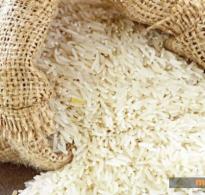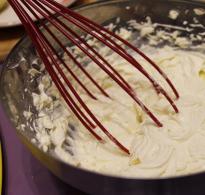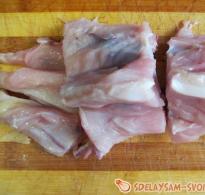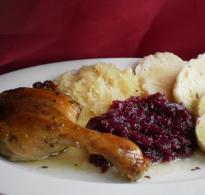Cheese tuyere d amber. French cheese Fourme d'Ambert
A French uncooked unpressed cow's milk cheese made in the Auvergne region. Throughout the volume of the cheese body are blotches of blue mold, which make its delicate taste spicy. The heads are covered with a dry thin crust of a grayish-red color. Its taste is considered the softest among all French blue cheeses, it is recommended to start eating them with it.
Due to the peculiar shape of the head - high and cylindrical - Fourmes d'Amber is called "the lady with a tender heart." Its height is 19-20 cm, diameter - 13 cm, weight - 2 kg.
Manufacturing
According to the AOC certificate, Fourmes d'Ambert is produced in 43 cantons of the Puy-de-Dome department, 8 communes of the Loire department and 5 cantons of the Cantal department. It is made from the milk of cows that graze high in the mountains (600-1600 meters above sea level). Here they eat such herbs as yellow gentian, forest lily, blueberry, chamomile, mountain cornflower. Cheese is produced from June to October.
Milk is collected in a large vat and heated to a temperature of 32 degrees. Then add rennet, which leads to coagulation, and penicillin, which is responsible for the formation of mold. After curdling, the resulting cheese mass is crushed into grains and kneaded for an hour to naturally separate the whey. During this process, the crushed cheese grains are covered with a thin film that prevents them from sticking together and provides a place for the development of blue mold.
At the next stage, the mass is laid out in forms and the whey is finally removed. To do this, the heads are placed in a warm room for a day and turned over several times. The cheese is then salted by hand, dry or in solution. After salting, it is left to "rest" for two days in a room with good ventilation.
In order for mold to develop in the middle of the heads, they are dived, or pierced, with long thick needles. Thus, mold spores receive oxygen.
For ripening, Fourmes d'Amber is placed in a cool room with high humidity, where he spends from 28 days to 4 months.
What is combined with
Fourme d'Amber is served warmed to room temperature at the end of the meal, before dessert. It is used in the formation of a cheese plate, salads, appetizers, soufflés, fillings for pancakes, pastries, sauces, hot dishes.
Fourmes d'Amber is combined with fruits, crackers, fresh bread, jams, as well as white sweets (Jurançon, Bergerac, Loupiac, Sauternes, Montbazillac, Barsac), pinks (Cote d'Auvergne), dry reds (Cote du Rhone village, Madiran, Cahors, Medoc) wines.
Story
Fourmes d'Amber is one of the oldest French cheeses. The first mention of it dates back to the 8th century. However, the French claim that it was known even under the Roman Empire, and the Gallic clergy (druids) used it when conducting cult rituals for pagan gods.
Fourmes d'Amber was used to pay tithes. In the town of Sholmes in Auvergne, a chapel from the 9th century has been preserved, the entrance of which is decorated with seven hewn "tithe" stones. These stones told the peasants what products they should bring as a sacred quitrent - sausage, butter, ham, hay, eggs, grain and Fourme d'Amber cheese. The latter was recognized by the characteristic shape of the head.
The cheese has been AOC certified since 2002.
The name of the cheese comes from the Latin "forma" (form) or the French "fromage" (cheese).
Every two years, the commune of Amber hosts a festival, Fourmo'folies, which is dedicated to this cheese.
Auvergne hold a competition for students of culinary schools "Les délices à la Fourme d'Ambert". Their task is to come up with a new recipe using Fourmes d'Amber.
FOURME D "AMBERT - LA FOURME D" AMBERT AND FOURME DE MONTBRISON (FOURME DE MONTBRISON)
Both varieties are named after the two small towns of Amber and Montbrison, located not far from each other on opposite slopes of the Forez mountains.
Fourm d'Amber and Fourm de Montbrison are cow's milk cheeses with unpressed pulp and mold interspersed. They are covered with a thin dry crust of gray or reddish color. They are easy to distinguish by a rather unusual shape compared to other cheeses: it is a cylinder weighing about 2 kg , whose height (19-20 cm) exceeds the size of the diameter (13 cm).They are considered one of the most delicate "blue" cheeses.
The word fourme, like the French word fromage (cheese) itself, comes from the word forme (form), denoting a cylindrical shape for curd mass.
Like it or not, the inhabitants of Auvergne claim that Furm d'Amber existed already during the time of the Roman Empire, which gradually conquered Gaul. Moreover, the Gallic druids (clerics) used this cheese in their worship of pagan gods.
With a sufficient degree of certainty, it can be argued that in the VIII-IX centuries Furm d "Amber was made on the territory of modern Auvergne. In the small Auvergne town of Chaulme there is a chapel built in the 9th century, above the entrance gate of which you can see seven hewn stones that were called " tithe stones". It was a kind of "cheat sheet" for serfs who were obliged to bring quitrent to priests - tithes. Oil, sausage, ham, eggs, hay, grain and cheese are carved on the stones, respectively, in the form of Furm d "Amber.
For centuries, Furmes d'Amber were produced exclusively by peasant farms. In the summer (from June to October), women and children settled in light sheds, which were called "jaseria" (jasserie) and served at the same time as a barn for livestock, a cheese factory and housing for people. Jacerias were built on the high hills, the men stayed in the valleys to make hay, the same day's milk was used to make lances, and the ripened cheese was sold in local markets.
In the 19th century, jacérie spread throughout the Auvergne, but in the 20th century they were gradually replaced by specialized farms for the production of cheeses. In 1900, about 200 tons of lances were produced. Today, its annual production is estimated at 7,000 tons, 35 times more than in 1900. This is the tenth largest among A.O.C cheeses. The triumph of this variety was the day on May 9, 1972, when Furm d "Amber / de Montbrison received the original controlled name.
The first operation for the production of Furm cheese takes place in a large vat into which milk is poured (travail en cuve). The quality of the future cheese largely depends on this stage. The milk in the vat is heated to 32 degrees. Penicillin is added to it to form mold and rennet for curdling. Then the curd mass is crushed, and then kneaded for more than an hour (to separate the whey).
The second stage is the layout of the curd mass in forms (moulage). When the curd mass was kneaded, each grain was covered with a thin film. This film prevents the grains from sticking together during the layout of the molds. In the resulting voids, noble mold will form.
The third stage is the removal of serum (egoutage). Forms with curd mass are placed in a warmer room for a day, during which they are turned over several times. Thus, the serum is drained. The future cheese takes the final cylindrical shape and weight (about 2 kg).
The fourth stage is the salting of cheeses (saumurage). They are either sprinkled manually with fine salt, or dipped in saline for several hours. After salting, the cheese should lie down for two days in a well-ventilated "rest" room.
The fifth stage is picking (piquage), that is, piercing the cheese through thick long needles. Thus, ventilation passages are made, since mold needs oxygen for its development. Thanks to these moves, the mold will normally develop even in the very center during the ripening of the cheese. As you can see, this operation can now be mechanized.
Finally, the last stage is maturation (affinage). Ripening takes place in a cool room. The first mold appears after a few days. In order for Furm to acquire a characteristic delicate taste and aroma, at least 28 days are needed.
Statistical studies show that approximately 20% of French families regularly consume Fourm d'Amber. This cheese is considered one of the most exquisite among the "blue" cheeses, although it is cheaper than Roquefort. French nutrition experts even recommend it to children. In the Foresian mountains The climate is fairly continental, with very hot summers, but also long and cold winters (by French standards, of course.) Cows graze between 600 and 1,600 meters above sea level. Mountain air and abundant vegetation on the mountain slopes ensure excellent milk quality. .
Furm can be consumed all year round.
Form Cylinder 19-20 cm high and 13 cm in diameter
Weight 2.0 - 2.1 kg
Pulp Soft unpressed with mold
Ripening period From 28 days
Production season June to October
Fat content 50%
Raw cow's milk
Best wine Chinon, Saint Nicolas de Bourgueil, Coteaux du Layon
(Puy-de-Dome, Auvergne)
at least 28 days
Story
The name of the cheese comes from the word form(form). Cheese Fourmes d'Amber was made already in the days of the Roman Empire. On May 9, 1972, Fourmes-de-Montbrison and Fourmes-d'Amber received the AOC certificate. On February 22, 2002, cheeses received separate native controlled names and differences in their production were recognized.
Manufacturing
Fourmes d'Amber is made in six stages. The production season is from June to October. It matures for at least 28 days.
| Stage name | Process |
|---|---|
| travail en cuve | Milk is poured into a large vat and heated to 32 °C. Then penicillin and rennet starter are added, after which the crushed curd mass is kneaded for about an hour to separate the whey. |
| moulage | Curd mass is laid out in forms |
| egoutage | Remove serum |
| Saumurage | The cheese is salted, after which it “rests” for two days in a well-ventilated area. |
| piquage | Cheese is pierced with thick long needles. This provides ventilation, which is necessary for the development of mold. |
| affinage | Ripening cheese in a cool room. Mold will form after a few days. |
In 2006, 6,200 tons of Fourme d'Amber were produced.
Fourmes d'Ambert is produced on a large territory:
- 43 cantons of the Puy-de-Dome department
- 8 communes from 3 cantons of the Loire department
- 5 northeastern cantons of the department of Cantal
Description
The cheese head has a cylindrical shape 19-20 cm high and 13 cm in diameter, weight ~2 kg.
Fourmes d'Amber is served before dessert and is used in the preparation of appetizers, salads, soufflés and as a filling for pancakes. Wine goes best with cheese Chinon, Saint Nicolas de Bourgueil, Coteaux du Layon.
Write a review on the article "Fourmes-d'Amber"
Notes
Links
| |||||||
I have two beautiful aprons in my kitchen at home and both are black. One, Canadian, Sasha gave, sent because of the bruise and even put a jar of wonderful Indian spices for steaks in her pocket (Hi, Sasha!) I don’t think that the chef himself sent it to me, as my friends assure, most likely they themselves stole it there in the kitchen and brought it to me. And I'm happy! I love my friends.
Why did I remember aprons? Because I heard it on the phone.
- Will you come? You promised!
- Oh, uh, uh, so many things, so many things, I don’t know .. (you have to let in solidity!)
- Then you will exterminate the orcs in the games, as if we do not know what you are doing. No, you promised and so you will come! And cook something delicious, real tasty taste. So please, please, please!
- I don't know what to please. Pork cutlets Rembrandt with marjoram and apples you refused to eat. But this is - wow what food!
- And at that time we were reading sunnahs from the Koran, we were interested, therefore we could not.
- OK then! Why were you snorting at the real Olivier? I tried so hard, I even made tarragon mayonnaise for it.
- So we are ordinary people, and you introduced us into shock by changing the usual. After all, Olivier, in our understanding, is a store-bought Provence, into which chopped sausage, boiled potatoes and green peas with cucumbers are stuffed! So your layers of truffled quail breasts fried in apricots were certainly unusual. Forgive us for this! And cook something tasty, creative. We promise to try! Honestly awesome! you yourself are in a high.
- Then ask for mercy!
- Uncle, forgive the asshole!
- Well, the sailor will not offend children. What do you want?
- And in the series we saw what the Shah is fed and even wrote down the name - Furm D "Amber with a baked pear.
- And all that? Chu, the government is worried about the nickel .. Okay, you will have a miracle.
I said so, but I myself don’t know what kind of crap this is that the paddling pools came up with .. I got into the Internet ... so, it’s clear that it’s a very delicate cheese with blue mold. And the recipes are all different! You'll have to improvise. I will combine the best and make my own kinic Furm D "Amber with a baked pear. On a whim)))
And it’s also strange that in a French restaurant this dish is ordered three days in advance .. Strange, really .. Maybe for show-off like that? it seems to be simple. And the wines recommended for it surprised me. Poyac. Chateau Colombier Montpélou. Cru Bourgeois Superière. I don't even know their names. Nothing! I will recommend mine from the bar myself. I have a lot of different bottles there.
I bought all the ingredients, and even more just in case, I'm coming soon. He put on a black apron, a red bandanna, picked up a knife ... took another ... and was stunned. Et-t-t-what kind of folk art? What have you done with the knives, mmm...craftswomen?
- So after all, we were afraid to distract you from business and sharpened the knives ourselves ...
(Well, yes. Japanese knives were sharpened with a European sharpening with a different angle, and German ones with a block ... Bruuuuuuuuuuuuuuuuuuuuuuuuuuuuuuuuuuuuuuuuuuuuuuuuuuuuuuuuuuuuuuuuuuuuuuuuuuuuuuuuuuuuuuuuuuuuuuuuuuuuuuuuuuuuuuuuuuuuuuuuuuuuuuuuuuuuuhhhk, tit-rub!!! Never, do you hear, my friend?!! Never trust women with steel knives, their handles are adapted for something else. And how did I not swear? And, most importantly, I didn’t say that women are fools? Otherwise, it would be trendy for me)))
- Hmmmmm. I understand, you are great, not confused without me. But here I am, a simpleton fool, I didn’t buy lemons, so I quickly drive back and forth ....
drove.
- Here, with a new thing for you, young ladies. Look at what beautiful, matte black knives, and you never need to sharpen, because they are ceramic.
- Oh, how wonderful! Nice ones! And where are the old ones with whom we suffered?
- And I took the old ones to the barn. In the spring we will be doing a knifffor installation.
Lied, damn it. Sakai left his beloved chef samurai. I corrected him, getting rid of the influence of female pens, he already sighed gratefully, and even drank a drop of my blood to recover, pulled it into his metal layers ... And then I wrapped his handle on top with black electrical tape for a villainous entourage - Look! You now have beautiful ceramic toys and no need to sharpen, just enjoy the glamour. Never pick up a man's knife! And then there will be chicks and you will become fat! Well ... now let's cook delicious!
- Let's! We now finally have cute little knives with drawings, we will help you!
- Today, the Krivoruks have a day off, rest, clumsy, I myself will create a miracle. Daddy will feed everyone!
And they ate it all! Already crackling behind the ears, yes, I personally listened to each ear. And "Delicious!" said. That's what it means to sit at the table with them with a whip and snap them!)))
Well, I almost forgot about improvisation. I even watched the episode where Chief Barinov was cooking for the Shah, but still brought in cynical nuances. Let's create something new!
It's simple, work for forty minutes and no Parisian days.)
Quickly fried shrimp in butter with garlic. I admired the miracle of how these crustaceans turned from slimy-gray into joyful white-red ones. Everything is in color!
The conference cut the pears in half, cleaned out a little bit of the inside and, tenderly, smeared it with a mixture of honey and mustard. Stuffed with finely chopped shrimp. And from above ... here is the detail. Since Furm D "Amber did not quickly find, because of the sanctions, he simply replaced it with Dor Blue and Parmesan. He beat a raw egg into grated cheese and placed it generously on top of the shrimp ....
And baked my created pears in the oven for twenty minutes.
... and I added mustard for the sake of creativity, I just pinned it. And I guessed with taste)))
You have to live nice and beautiful, right?)
mesophilic lactic cultures - 1/2 teaspoon
blue penicillin mold (powder) - 1/8 teaspoon
calcium chloride - 1/2 teaspoon
liquid rennet sourdough - 1/2 teaspoon
salt
by two kilograms
Sterilize all kitchen utensils and utensils that you will use (spoons, pots, measuring containers, etc.). Work surfaces on which you will put kitchen utensils, carefully pierce with hot soapy water, then with clean water and disinfect.
We put a large saucepan with milk in a hot water bath and, stirring slightly, heat the milk over medium heat to 32 ° C. Let's turn off the fire.
Put the lactic acid cultures and blue mold on top of the milk and let it sit for about 5 minutes to curdle. Using a slotted spoon, move the cultures to the bottom using a downward motion without shaking the milk.
Dilute the calcium chloride with 1/4 cup (50 milliliters) of cold water and add to the milk from top to bottom.
Dilute the rennet starter with 1/4 cup (50 milliliters) of cold water and add to the milk. From top to bottom, move the starter to the bottom and mix the mixture well. Cover the milk with a towel and let it sit for 1 hour 30 minutes, keeping the temperature at 32 °C.
Insert the long, flat blade of a cheese knife into the curd at a 30° angle and slowly lift towards the surface of the curd. If the curd cracks or breaks, it can be cut. If the break is uneven and insignificant, leave the cottage cheese for another 15 minutes and then try to cut it again.
Using a knife with a long blade and a slotted spoon, cut the cottage cheese
in a saucepan with 1.2 cm cubes. To do this, first cut it vertically with a knife into strips 1.2 cm wide. Then we cut it into the same strips, but already perpendicular to the first, so that squares are obtained on the surface of the curd. After that, with a slotted spoon, cut off the top layer of cottage cheese to a depth of 1.2 cm so that cubes are obtained. Cut the rest of the curd in the same way. Leave the cottage cheese for 5 minutes to separate the whey.
Stir the cottage cheese constantly with a slotted spoon in a water bath for 1 hour, maintaining the temperature at 32 ° C, until its pieces decrease in size to 1 cm. Leave the cottage cheese to settle.
Cups with salt from the pan excess whey to the surface of the curd mass. We put the cottage cheese in a cheese mold 20 cm and 10 cm high, lined with a piece of gauze. Lift the ends of the fabric, collect over the cottage cheese and tie. Cover the cottage cheese with a lid smaller than the mold diameter. Place a small weight on top and leave for 1 hour.
Remove the load, untie the gauze, remove the cottage cheese from the mold, turn it over and put it back into the mold, wrap it with a cloth and install the load. Leave the cottage cheese under pressure for 6-7 hours.
Let's prepare the brine. To do this, mix water with salt in a ratio of 5: 1. We heat the water until the salt dissolves, then cool it to 13 ° C.
Remove the load from the mold, untie the gauze, remove the cottage cheese from the mold and give it out in brine for 12 hours, turning it over after 6 hours.
Put the cheese on a metal grill and leave to ripen for 2 days at room temperature.
Prepare a container for drying cheese. You will need a large (30L) plastic (not colored) food storage container with a lid. Place a baking rack inside the container and cover it with a large white plastic cutting board. Lay a cheese mat or bamboo sushi mat on the board (treat before use).
With a knife or skewer, wash the head of cheese through the top, bottom and sides several times. We put the cheese in a container, close it with a lid and leave the cheese to ripen at 10 ° C and a humidity of 90% for 1 month. Turn cheese daily, removing excess whey from the bottom of the container with a paper towel. After 2 weeks of ripening, blue mold will begin to appear on the surface of the cheese. After a month of ripening, the cheese is ready for consumption. Pack it in foil. Cheese can be stored in the refrigerator for 2-3 months.
Use the tips and comments from the article "Make your own cheese."
Enjoy your meal!






